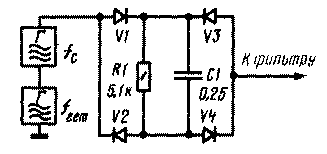
|
|
ENCYCLOPEDIA OF RADIO ELECTRONICS AND ELECTRICAL ENGINEERING Automatic offset in the mixer. Encyclopedia of radio electronics and electrical engineering
Encyclopedia of radio electronics and electrical engineering / radio reception A mixer based on anti-parallel diodes [1] makes it possible to implement high sensitivity and noise immunity of direct conversion receivers, a low local oscillator voltage level at the antenna input. However, such a mixer has a drawback - it requires an accurate selection of the local oscillator voltage. The fact is that in order to obtain the maximum transmission coefficient of the mixer, the diodes should open only at the peaks of the heterodyne voltage Uget (Fig. 1), and the duty cycle t/T of the current pulses iд through the diodes should be approximately 0,5. If the mixer uses silicon diodes with a cutoff voltage Uots equal to 0,5 V, then the amplitude of the heterodyne voltage should be 0,6 ... open. In both cases, the mixer gain decreases.
The above disadvantage can be eliminated by introducing an automatic bias circuit into the mixer, which, when the local oscillator voltage changes, will correspondingly change the cutoff voltage of the diodes, thereby maintaining a constant duty cycle of the current pulses through the diodes. The modified mixer circuit is shown in Fig.2. To increase the symmetry of the mixer, two more back-to-back diodes V3, V4 are added to it, and the automatic bias circuit R1C1 is included in the diagonal of the bridge formed. The time constant of the R1C1 chain must be greater than the period of the lowest reproducible audio frequency, otherwise the mixing voltage will be "modulated" by the output signal.
The current pulse during the positive half-cycle of the local oscillator voltage passes through the diodes V1 and V4, and during the negative half-cycle through V2 and V3. In both cases, these pulses cause a mixing voltage on the elements R1, C1, proportional to the amplitude of the local oscillator signal. The described mixer can be slightly improved (Fig. 3) by connecting the signal source and load to the midpoint of the coupling coil (L2) and the midpoint of the automatic mixing circuit, respectively. In this case, the connection between the local oscillator and signal circuits is greatly weakened, since they are included in different diagonals of the balanced bridge.
The input signal from the tap of the coil circuit L1C2, tuned to the frequency of the signal, is applied to the midpoint of the coupling coil L2. Coil L3 can be a loop local oscillator coil tuned to a frequency equal to half the frequency of the signal. If there is a buffer stage in the local oscillator, the windings of a high-frequency transformer wound on a ferrite ring can serve as coils L2 and L3. For the local oscillator voltage, the mixer diodes V1 - V4 form a bridge rectifier, and the bias voltage is allocated on the RIC4C5 chain. The low-frequency signal is taken from the connection point of the bias circuit capacitors and fed to the L4C6C7 low-pass filter with a cutoff frequency of 3 kHz and then to the low-pass amplifier. Since there is no constant voltage component at the mixer output, a decoupling capacitor at the input of the low-frequency amplifier is not needed. Both mixer circuits (Figures 2 and 3) were tested in a direct conversion receiver on the 80 m band [2]. It turned out that both silicon and germanium diodes are suitable for a mixer with automatic bias and give approximately the same results. You can use diodes (the list goes from worst to best) D18, D20, D101-D105, D219-D223, D2, D9, D311, KD503, KDS523, KD514. Measurements of the mixer parameters showed that its transmission coefficient remained the same (the sensitivity of the receiver - 1,5 μV - did not change). The sensitivity of the receiver remained almost the same when the amplitude of the local oscillator voltage changed from 1 to 4,5 V (it was controlled between the extreme terminals of the L2 coil). The attenuation of the local oscillator signal with a frequency of 1,75 MHz at the tap of the L1 coil was 54 dB. Additional suppression of the local oscillator signal occurs in the input circuit. The attenuation of interfering AM signals exceeded 80 dB - an AM signal with an amplitude of 0,1 V at a modulation depth of 30% and a detuning of ± 50 kHz gave the same voltage at the receiver output as a useful signal with an amplitude of 7 μV. Literature: 1. V. Polyakov. Direct Conversion Receiver Mixer - "Radio". 1976, No. 12 from 18-19
Author: V. Polyakov (RA3AAE), Moscow; Publication: N. Bolshakov, rf.atnn.ru
Artificial leather for touch emulation
15.04.2024 Petgugu Global cat litter
15.04.2024 The attractiveness of caring men
14.04.2024
▪ The nurses will scrub the copper ▪ Solar panels from vegetable biomass ▪ Human sweat is a source of energy ▪ Prostheses that feel heat and touch
▪ site section Lighting. Article selection ▪ article Use of water from natural reservoirs as a coolant. Fundamentals of safe life ▪ Article Head of Sales. Job description ▪ article Riddles about household appliances
Home page | Library | Articles | Website map | Site Reviews www.diagram.com.ua |






 Arabic
Arabic Bengali
Bengali Chinese
Chinese English
English French
French German
German Hebrew
Hebrew Hindi
Hindi Italian
Italian Japanese
Japanese Korean
Korean Malay
Malay Polish
Polish Portuguese
Portuguese Spanish
Spanish Turkish
Turkish Ukrainian
Ukrainian Vietnamese
Vietnamese



 Leave your comment on this article:
Leave your comment on this article: